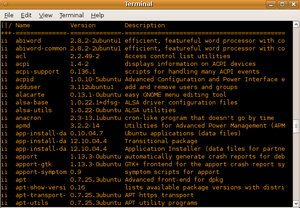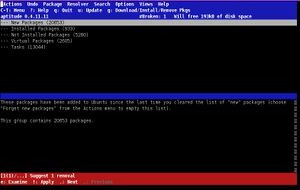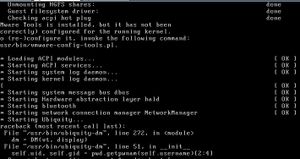COMP 3000 2011 part2 ttian1: Difference between revisions
Created page with "=Part2= == Brief background for Hannah Montana Linux == The name of my distribution is Hannah Montana Linux which is developed by Hannah Montana fans. Hannah Montana Linux is a i…" |
|||
| Line 190: | Line 190: | ||
As the prefix S means start and the number following S determines the order to run the scripts, these five programs runs with the order log deamon, Kernel log deamon, System kernel message dbus, Hardware abstraction layer hald and Bluetooth just as the picture. | As the prefix S means start and the number following S determines the order to run the scripts, these five programs runs with the order log deamon, Kernel log deamon, System kernel message dbus, Hardware abstraction layer hald and Bluetooth just as the picture. | ||
= Reference = | = Reference = | ||
< | <references /> | ||
Revision as of 18:48, 21 December 2011
Part2
Brief background for Hannah Montana Linux
The name of my distribution is Hannah Montana Linux which is developed by Hannah Montana fans. Hannah Montana Linux is a is a free operating system based on Kubuntu with a Hannah Montana theme. It is fast, stable and powerful.
It includes a Hannah Montana themed boot screen, KDM(KDE Display Manager), icon set, color scheme, wallpapers an so on. The Package Manager of Hannah Montana Linux is Debian apt and its GUI(Graphical user interface) is KDE 4.2 with Hannah Montana themes.<ref>About Hannah Montana Linux. Retrieved December 12, 2011 from http://hannahmontana.sourceforge.net/Site/About.html</ref> KDE 4.2 is the KDE 4.2 platform <ref>KDE platfrom. Retrieved December 15,2011 from http://en.wikipedia.org/wiki/KDE_Software_Compilation</ref>developed by KDE which is an international free software community producing an integrated set of cross-platform applications designed to run on Linux, FreeBSD, Microsoft Windows, Solaris and Mac OS X systems.<ref>KDE community. Retrieved December 15, 2011 from http://en.wikipedia.org/wiki/KDE</ref>
Unlike other distributions, as Hannah Montana Linux just a stripped down version of Kubuntu with a Hannah Montana-inspired desktop theme that could theoretically make the operating system slightly more attractive to children.
The hannah_montana_linux_x86_basic_edition.iso file is 691 MB. However, after installed, it will become 3.10GB
Software Packaging
Packaging Format and Utilities
Hannah Montana Linux is a unix-like Linux Operating System based on Kubuntu. The package manager of it is Debian apt(for Advanced Package Tool) which is a higher level tool than dkpg<ref name="dkpg">Debian dkpg Package Tool. Retriever November 14, 2011 from http://en.wikipedia.org/wiki/Dpkg</ref> and the package format is .deb.<ref name=".deb"> .deb format. Retrieved December 12, 2011 from http://www.debian.org/doc/manuals/debian-faq/ch-pkg_basics</ref> This package manager works with dkpg to install, remove, update, resolves problems of dependencies and retrieves the requested packages.<ref name="apt">Debian Apt Package Tool. Retriever November 14, 2011 from http://wiki.debian.org/Apt</ref> In addition to apt and dkpg, Hannah Montana Linux also use aptitude as one of utilities for package management.
Listing Installed Packages
As Hannah Montana Linux uses dpkg, apt and aptitude as packager tools, there several ways to get the list of installed packages.

You can use command “dpkg –l” or just use “aptitude” to go to the package management windows provided by aptitude to view all the installed packages.
Adding and Removing Packages
To add packages, you can use dpkg -i <package name.deb> where your current directory should contain the package. You can use "aptitude" command to install packages in the aptitude windows or use "apt-get install <package>” command to do the installation.
To remove packages, you can use "dpkg -r <package_name>" which will leave the configuration file or "dpkg -pure <package_name>" which will remove the configuration as well. You can use "aptitude" command to remove packages in the aptitude windows or use "apt-get remove <package>” command to do that.

Software Catalog
By using command “aptitude”, you can view the information of the packages of Hannah Montana Linux. It shows that there are 20653 new packages, 933 installed packages, 5280 not installed packages, 2605 virtual packages and 13044 tasks. By clicking the options, you can enter the sub-directories to view those packages which are new, installed or virtual packages for utilities such as admin, base, devel, doc, editors, kde and so on.
Major package versions
The table below lists the version numbers and upstream sources of various major software packages included in Hannah Montana Linux
| Package | Version | Latest Official Release | Official Source | fork | Command |
|---|---|---|---|---|---|
| Linux Kernel | 2.6.28-13-generic #44 Ununtu
(2009-07-02 ) |
3.1.1<ref>The Linux Kernel Archives. Retrieved November 14, 2011 from http://www.kernel.org/</ref>
(2011-11-11) |
http://www.kernel.org/ | https://launchpad.net/ubuntu/+source/linux/2.6.28-13.44/+build/1055416 | uname -a |
| Glibc | GNU libc 2.9
(2009-05-17) |
2.14<ref>GNU C Library. (Oct 17,2011). Retrieved on November 14, 2011 from http://en.wikipedia.org/wiki/GNU_C_Library</ref>
(Oct 17,2011) |
http://www.gnu.org/s/libc/ | http://ftp.gnu.org/gnu/libc/ | Command /lib/libc.so.6 --version |
| X.org X server | X server 1.6.0
(2009-2-25) |
X server 1.11.2 <ref>X server. Retrieved on November 14, 2011 from http://www.x.org/wiki/Releases?action=show&redirect=XorgReleases</ref>
(2011-11-04) |
http://www.x.org/wiki | https://launchpad.net/ubuntu/+source/xorg-server/2:1.6.0-0ubuntu14 | X –version |
| Bash (Shell) | 3.2.48(1)
(2008-11-18) |
4.2 <ref>Bash. Retrieved November 14, 2011 from http://en.wikipedia.org/wiki/Bash_%28Unix_shell%29</ref>
(2011-Oct-25) |
http://www.gnu.org/software/bash/ | http://ftp.gnu.org/gnu/bash/ | bash –version |
| Gcc(the GNU Compiler Collection) | 4.3.3
(2009-01-24) |
4.6.2 <ref>Gcc. Retrieved on November 14, 2011 from http://gcc.gnu.org/</ref>
(2011-08-26) |
http://gcc.gnu.org/ | http://gcc.gnu.org/gcc-4.3/ | gcc –version |
| DPKG | 1.14.24 ubuntu1
(2008-12-29 ) |
1.16.1.2(test) <ref> DPKG Retrieved December 16, 2011 from http://packages.debian.org/wheezy/dpkg</ref>
(2011-12-16) |
http://packages.debian.org/wheezy/dpkg | https://launchpad.net/debian/+source/dpkg/1.14.24 | dpkg –version |
| KDE | 4.2.2
(2009-04-02) |
4.7.1<ref>KDE. Retrieved on November 14, 2011 from http://busybox.net/</ref>
(2011-09-07) |
http://www.kde.org/ | http://www.kde.org/info/4.2.2.php | the About KDE option in the tool bar |
| Amarok(Audio Player) | 2.0.2
(2009-03-05) |
2.5 Beta1 <ref>Audio Player. Retrieved on November 23, 2011 from http://src.chromium.org/viewvc/chrome/releases/?sortby=date</ref> | http://amarok.kde.org/ | http://amarok.kde.org/en/releases/2.0.2 | the About Amarok option in the tool bar |
| QT | 4.5.0
(2009-05-11) |
4.7.4 <ref>QT. Retrieved November 14, 2011 from http://en.wikipedia.org/wiki/Qt_(framework)</ref>
(2011-09-01) |
http://qt.nokia.com/ | http://qt.nokia.com/products/changes/changes-4.5.0/ | conqueror -v |
| GZIP | 1.3.12
(2007-04-13) |
1.4 <ref>GZIP. (2011, Oct. 25). Retrieved on November 14, 2011 from http://ftp.gnu.org/gnu/gzip/</ref>
(2010-01-20) |
http://ftp.gnu.org/gnu/gzip/ | http://ftp.gnu.org/gnu/gzip/ | gzip --version |
Comparison of Packages to their Latest Stable Release
Hannah Montana Linux is based on Kubuntu.
The following table will discuss some of the differences between these packages and their upstream counterparts, as well as the services they provide.
| Package | Purpose and Differences from Upstream Source |
|---|---|
| Linux Kernel | The Linux kernel is an operating system kernel used by the Linux family of Unix-like operating systems.
While a list of the individual modifications done to version 2.6.28-13.44_i386 would be too long to list, all of the changes are listed in the change log inside the diff file.For example, it adds missing mvsas (Marvel SAS 6440) module configuration and support for G41 chipset. It is developed for Ubuntu Jaunty i386. |
| Glibc | The GNU C library(Glibc) is used as the C library in the GNU system and most systems with the Linux kernel.
According to the change log in the diff file, there are quite a lot of modifications for 2.9 release. The user-visible change for this release includes new Linux interfaces, new fixed-size conversion macros and so on. |
| X.org | Xorg refers to the X server release packages stewarded by the X.Org Foundation, which is hosted by freedesktop.org, and grants public access to the standard X Window releases for the efforts of the free and open source software community. There are no huge changes since 1.5.99.903.diff file. Some typos and bugs are fixed. Xorg provides the basis for GUIs. |
| Bash | Bash is a Unix shell written by Brian Fox for the GNU Project as a free software replacement for the Bourne shell (sh).
No huge changes are made to bash-3.2.48 compared to bash-3.2-beta. According to the change log in the source package, several bugs are fixed. For example a bug in the printf builtin that caused the %q format specifier to ignore empty string arguments.c is fixed. |
| GCC | The GNU Compiler Collection (GCC) is a compiler system produced by the GNU Project supporting various programming languages.
After reading the change log in the diff file, I have found that some architectures and ports are declared obsolete, some options such as -fforce-mem are removed as well. |
| DPKG | Dpkg is the software at the base of the Debian package management system. dpkg is used to install, remove, and provide information about .deb packages.
According to the change log in the diff file, there are few changes made to DPKG 1.14.24. It fixes mostly the parsing of objdump output (by dpkg-shlibdeps) in a special case where the symbol name is separated only with a single space, dpkg-shlibdeps behaviour when Build-Depends-Package is used in the symbols file and dpkg-source to correctly extract a source package even when called from a non-writable directory when a target directory has been specified on the command line. |
| KDE | KDE offers a full suite of user workspace applications which allow interactions with these operating systems in a modern, graphical user interface.
The most user-visible improvements made to KDE 4.2.2 according to the Enhancements section in the announcements. The first improvement is that KRunner's threaded search for results is now more robust and a possible deadlock condition has been fixed. The second one is that Synching email of cached IMAP accounts is now faster and a number of displaying changes makes reading emails smoother experiences. The third one is that Text rendering has been optimized, support for CSS selectors has further been improved as well. In addition to that, there are lots of modifications in the change log in the diff file as well. |
| Amarok | Amarok is a powerful music player for Linux and Unix, MacOS X and Windows with an intuitive interface.
After reading the announcement, I have found that there are major changes which are made to Amarok 2.0.2. The first change is that it will show a statusbar message when loving a lastfm track. The second one is that an error message will be showed when Wikipedia information cannot be retrieved. Of course, bugs are fixed. |
| QT | QT is a cross-platform application framework that is widely used for developing application software with a graphical user interface (GUI) and also used for developing non-GUI programs such as command-line tools and consoles for servers.
According to the change log in the diff file, there are many new features added to the QT 4.5.0, such as the ability to set the text margin size. Some functions such as QGraphicsView are optimized, bugs are fixed as well. |
| GZIP | Gzip is any of several software applications used for file compression and decompression.
After reading the change log in the source package, I have found that there are many tiny changes are made to gzip-1.3.13, including names changed such as README-cvs, files added such as stdlib_h.m4 and removed such as getdelim.c. |
Initialization
When the computer is powered on, firstly the BIOS performs integrity checks on memory and seeks instructions on the MBR on the floppy drive or hard drive.Then the MBR points to the boot loader GRUB(short for GRand Unified Bootloader) as Hannah Montana Linux is based off of Kubuntu. After the kernel is built up, because Ubuntu 6.10 (Edgy Eft) and later contain Upstart as a replacement for the traditional init-process,<ref> Kunbuntu init process. Retrieved December 10, 2011 from http://en.wikipedia.org/wiki/Runlevel</ref> Hannah Montana Linux use upstart to initialize the system, where upstart is an event-based replacement for the traditional init daemon — the method by which several Unix-like computer operating systems perform tasks when the computer is started. <ref> Upstart. Retrieved December 10, 2011 from http://en.wikipedia.org/wiki/Upstart </ref>
The upstart use the /etc/event.d directory(Hannah Montana Linux use /event.d to replace inittab file) to store the information of those events which upstart will run, in other words, upstart use /etc/event.d as the guide to determine the sequence to run scripts and match the paths of scripts. In the /etc/event.d directory, there is a rc-default file which is similar to the inittab and it contains the information about the default run-level. Upstart comes with a set of default jobs which it installs into /etc/init. These are based on the sysvinit configuration of Debian-based systems, including running the /etc/init.d/rc script which contains a number of start/stop scripts for various services and tasks on your system.
When running upstart, firstly, the kernel runs init. Secondly, init goes to the /etc/event.d directory, finds the rc-default file and determines the run-level. Thirdly, it runs /etc/event.d/rc#(# stands for 0,1,2,3,4,5,6). Then rc# runs /etc/init.d/rc and # is passed to /etc/init.d/rc as a parameter. After that, init goes to /etc/rc#.d directory to start or stop processes and tasks according to their priorities. <ref> How upstart work. Retrieved December 12, 2011 from http://upstart.ubuntu.com/getting-started.html </ref><ref> More about upsart Retrieved December 12, 2011 from http://www.xxlinux.com/linux/article/development/kernel/20081128/14566.html </ref>

Finally, the init program runs six terminals and bring users to the login GUI windows, and the initialization is done.<ref> How to init. Retriever December 12, 2011 from http://www.yolinux.com/TUTORIALS/LinuxTutorialInitProcess.html</ref> By viewing the /etc/rc#.d directory(# stands for 0,1,2,3,4,5,6), I have found the scripts corresponding to System log deamon, Kernel log deamon, System kernel message dbus, Hardware abstraction layer hald and Bluetooth are S10sysklgd, S11klogd, S12dbus, S24hal and S25bluetooth. As the prefix S means start and the number following S determines the order to run the scripts, these five programs runs with the order log deamon, Kernel log deamon, System kernel message dbus, Hardware abstraction layer hald and Bluetooth just as the picture.
Reference
<references />